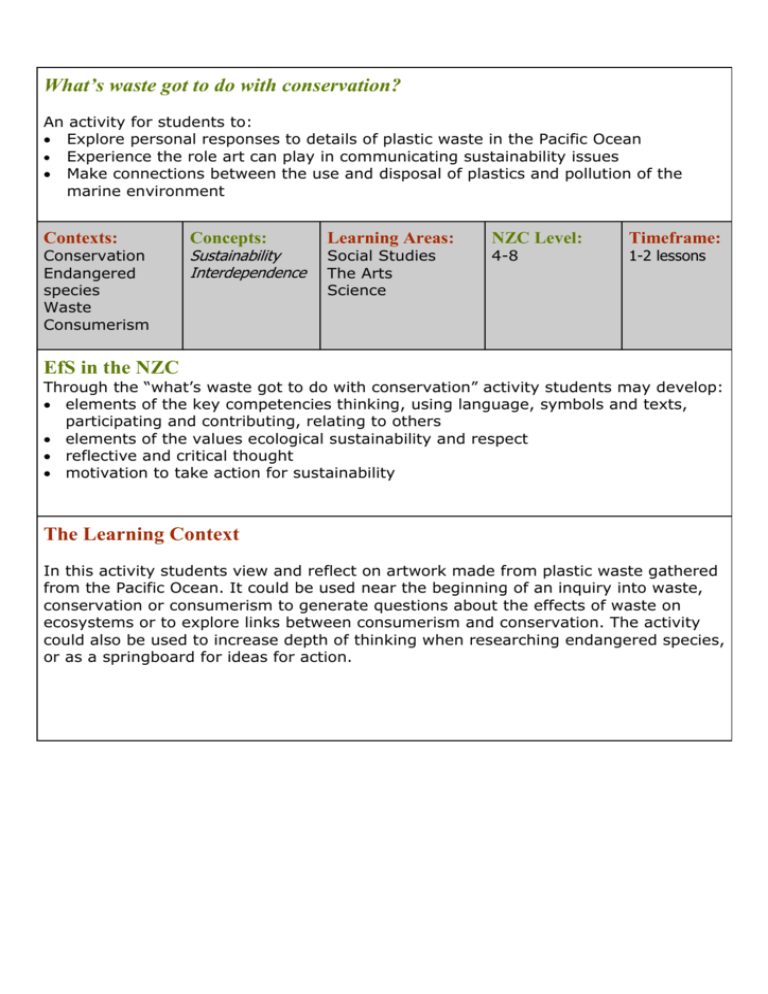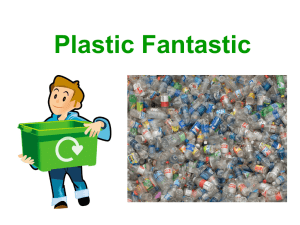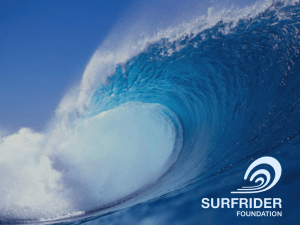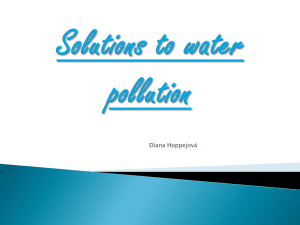What`s waste got to do with conservation
advertisement

What’s waste got to do with conservation? An activity for students to: Explore personal responses to details of plastic waste in the Pacific Ocean Experience the role art can play in communicating sustainability issues Make connections between the use and disposal of plastics and pollution of the marine environment Contexts: Conservation Endangered species Waste Consumerism Concepts: Sustainability Interdependence Learning Areas: NZC Level: Social Studies The Arts Science 4-8 Timeframe: 1-2 lessons EfS in the NZC Through the “what’s waste got to do with conservation” activity students may develop: elements of the key competencies thinking, using language, symbols and texts, participating and contributing, relating to others elements of the values ecological sustainability and respect reflective and critical thought motivation to take action for sustainability The Learning Context In this activity students view and reflect on artwork made from plastic waste gathered from the Pacific Ocean. It could be used near the beginning of an inquiry into waste, conservation or consumerism to generate questions about the effects of waste on ecosystems or to explore links between consumerism and conservation. The activity could also be used to increase depth of thinking when researching endangered species, or as a springboard for ideas for action. Teaching as Inquiry p.35 NZC When planning consider these questions Concepts for EfS Teachers need to connect students’ learning to concepts in EfS and school based broad understandings for learning so that students can make sense of their knowledge about their experiences of and attitudes towards sustainability. Through the activity students will develop an understanding of the concepts of: Sustainability by thinking about the effects of plastic waste on the marine ecosystem. Interdependence by making connections between the ways plastics enter the marine environment and their use and disposal of plastics. Learning areas Social Sciences Social Studies Understand how innovation such as the invention of plastic creates opportunities for people and challenges for the environment. Geography Understand how people interact with the natural environment and that this interaction has consequences. Focusing the inquiry What are our students’ needs and abilities? How do we know? (What is our evidence base?) What is the focus of our learning? How are we ensuring students are developing a concept of a sustainable future? What are we doing to help our students develop significant understandings across a range of learning areas? What do we want students to know and understand as a result of this learning? The Arts Consider and reflect on the contexts underlying the Chris Jordan artwork on plastic waste in the Pacific Ocean. Evaluate ideas and interpret the artists’ intentions in artworks. Science Explain how marine animals have responded to the humaninduced change of plastic in their habitat. Investigate the impact of human actions regarding waste on a New Zealand marine ecosystem. Use their growing scientific knowledge when considering the issue of plastics in the pacific ocean, explore aspects of this issue and make decisions about possible actions. Student learning outcomes Possible learning outcomes from this activity are: Awareness of the amount of plastic waste in the Pacific Ocean. Teaching inquiry Will this strategy Thinking reflectively about personal responses to visual details of the waste in the Pacific Ocean. Thinking critically about the impact of plastic waste on the marine ecosystem. Understanding of how plastic waste gets into the ocean. support my students to learn this? How will we know? Learning sequence As a class view the Chris Jordan artwork “Gyre, 2009” on http://www.chrisjordan.com/gallery/rtn2/ - gyre (scroll down to Gyre, 2009 which is a series of 11 images) This artwork is a series of 11 images, which become more detailed as you scroll down the page. 1. Start at the first image - this depicts 2.4 million pieces of plastic, equal to the estimated number of pounds of plastic pollution that enter the world's oceans every hour. All of the plastic in this image was collected from the Pacific Ocean. As a class view the image Reflect: (this could be in pairs, individually writing down the reflections or as a small group) o What was your first thought about this image? o What does this image make you think about? o How does this image make you feel? o What stands out to you the most in this image? 2. Proceed to the next image, announce what that part of the image is (this is at the top of each image) and do the same reflective exercise. 3. Repeat until all 11 images have been viewed and reflected on. 4. After viewing all 11 images reflect on these questions: What are your thoughts after seeing this artwork? How do you feel after seeing all these images? What stood out for you? If you were telling someone else about this artwork what would you say to them about it? What are the sources of the plastic? (Dig deeper with this line of questioning – it’s not just people littering on the beach or things dropping off boats, get students to consider rubbish blowing out of rubbish bins or landfills, plastics dropping out of recycling bins when they’re being emptied and then being washed into the stormwater system) What effects do you think this plastic in the Pacific Ocean is having? What’s waste got to do with conservation? Teaching and learning Learning inquiry What happened during the learning? How did my students respond? How will this learning contribute to a sustainable future? How can this learning make a difference? What is next? Next steps: Possible next steps: Exploring further questioning: o What further questions do you have about the impact of waste on the endangered animal you are studying? o What questions do you have about the impact of other types of waste on the ecosystem you are studying? o What further questions do you have about where waste in the marine environment comes from? o How will you find answers to these questions? Springing into action - what can we do to prevent waste polluting our ecosystems / endangering species? o Brainstorm all possible actions o Devise criteria for a successful action (eg has a long term positive effect on the environment, prevents pollution from occurring in the first instance, rather than being an ambulance at the bottom of the cliff, involves lots of people, we can achieve it, people will be interested etc). Once the decision on action has been made make a plan for action. o Use the plan to create timelines and who’s doing what lists and take action. Focusing inquiry What are my student’s needs and abilities? How do I know? What is the next focus for our learning?





